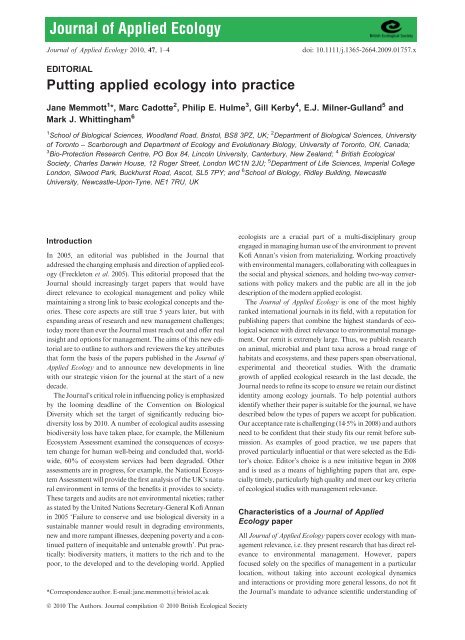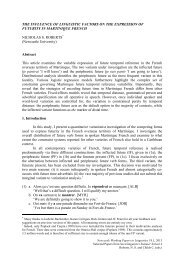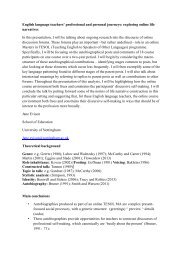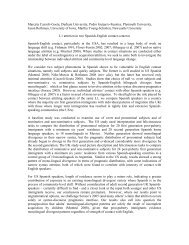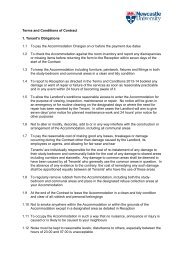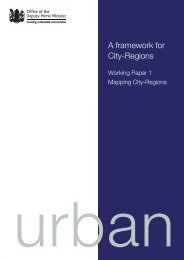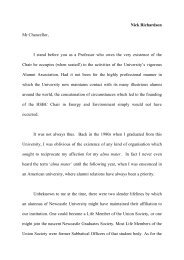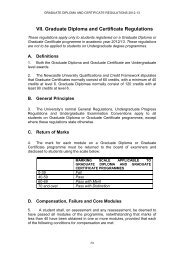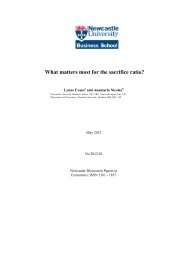Putting applied ecology into practice - Newcastle University
Putting applied ecology into practice - Newcastle University
Putting applied ecology into practice - Newcastle University
You also want an ePaper? Increase the reach of your titles
YUMPU automatically turns print PDFs into web optimized ePapers that Google loves.
Journal of Applied Ecology 2010, 47, 1–4 doi: 10.1111/j.1365-2664.2009.01757.x<br />
EDITORIAL<br />
<strong>Putting</strong> <strong>applied</strong> <strong>ecology</strong> <strong>into</strong> <strong>practice</strong><br />
Jane Memmott 1 *, Marc Cadotte 2 , Philip E. Hulme 3 , Gill Kerby 4 , E.J. Milner-Gulland 5 and<br />
Mark J. Whittingham 6<br />
1 School of Biological Sciences, Woodland Road, Bristol, BS8 3PZ, UK; 2 Department of Biological Sciences, <strong>University</strong><br />
of Toronto – Scarborough and Department of Ecology and Evolutionary Biology, <strong>University</strong> of Toronto, ON, Canada;<br />
3 Bio-Protection Research Centre, PO Box 84, Lincoln <strong>University</strong>, Canterbury, New Zealand; 4 British Ecological<br />
Society, Charles Darwin House, 12 Roger Street, London WC1N 2JU; 5 Department of Life Sciences, Imperial College<br />
London, Silwood Park, Buckhurst Road, Ascot, SL5 7PY; and 6 School of Biology, Ridley Building, <strong>Newcastle</strong><br />
<strong>University</strong>, <strong>Newcastle</strong>-Upon-Tyne, NE1 7RU, UK<br />
Introduction<br />
In 2005, an editorial was published in the Journal that<br />
addressed the changing emphasis and direction of <strong>applied</strong> <strong>ecology</strong><br />
(Freckleton et al. 2005). This editorial proposed that the<br />
Journal should increasingly target papers that would have<br />
direct relevance to ecological management and policy while<br />
maintaining a strong link to basic ecological concepts and theories.<br />
These core aspects are still true 5 years later, but with<br />
expanding areas of research and new management challenges;<br />
today more than ever the Journal must reach out and offer real<br />
insight and options for management. The aims of this new editorialaretooutlinetoauthorsandreviewersthekeyattributes<br />
that form the basis of the papers published in the Journal of<br />
Applied Ecology and to announce new developments in line<br />
with our strategic vision for the journal at the start of a new<br />
decade.<br />
The Journal’s critical role in influencing policy is emphasized<br />
by the looming deadline of the Convention on Biological<br />
Diversity which set the target of significantly reducing biodiversity<br />
loss by 2010. A number of ecological audits assessing<br />
biodiversity loss have taken place, for example, the Millenium<br />
Ecosystem Assessment examined the consequences of ecosystem<br />
change for human well-being and concluded that, worldwide,<br />
60% of ecosystem services had been degraded. Other<br />
assessments are in progress, for example, the National Ecosystem<br />
Assessment will provide the first analysis of the UK’s natural<br />
environment in terms of the benefits it provides to society.<br />
These targets and audits are not environmental niceties; rather<br />
as stated by the United Nations Secretary-General Kofi Annan<br />
in 2005 ‘Failure to conserve and use biological diversity in a<br />
sustainable manner would result in degrading environments,<br />
new and more rampant illnesses, deepening poverty and a continued<br />
pattern of inequitable and untenable growth’. Put practically:<br />
biodiversity matters, it matters to the rich and to the<br />
poor, to the developed and to the developing world. Applied<br />
*Correspondence author. E-mail: jane.memmott@bristol.ac.uk<br />
Ó 2010 The Authors. Journal compilation Ó 2010 British Ecological Society<br />
ecologists are a crucial part of a multi-disciplinary group<br />
engaged in managing human use of the environment to prevent<br />
Kofi Annan’s vision from materializing. Working proactively<br />
with environmental managers, collaborating with colleagues in<br />
the social and physical sciences, and holding two-way conversations<br />
with policy makers and the public are all in the job<br />
description of the modern <strong>applied</strong> ecologist.<br />
The Journal of Applied Ecology is one of the most highly<br />
ranked international journals in its field, with a reputation for<br />
publishing papers that combine the highest standards of ecological<br />
science with direct relevance to environmental management.<br />
Our remit is extremely large. Thus, we publish research<br />
on animal, microbial and plant taxa across a broad range of<br />
habitats and ecosystems, and these papers span observational,<br />
experimental and theoretical studies. With the dramatic<br />
growth of <strong>applied</strong> ecological research in the last decade, the<br />
Journal needs to refine its scope to ensure we retain our distinct<br />
identity among <strong>ecology</strong> journals. To help potential authors<br />
identify whether their paper is suitable for the journal, we have<br />
described below the types of papers we accept for publication.<br />
Our acceptance rate is challenging (14Æ5% in 2008) and authors<br />
need to be confident that their study fits our remit before submission.<br />
As examples of good <strong>practice</strong>, we use papers that<br />
proved particularly influential or that were selected as the Editor’s<br />
choice. Editor’s choice is a new initiative begun in 2008<br />
and is used as a means of highlighting papers that are, especially<br />
timely, particularly high quality and meet our key criteria<br />
of ecological studies with management relevance.<br />
Characteristics of a Journal of Applied<br />
Ecology paper<br />
All Journal of Applied Ecology papers cover <strong>ecology</strong> with management<br />
relevance, i.e. they present research that has direct relevance<br />
to environmental management. However, papers<br />
focused solely on the specifics of management in a particular<br />
location, without taking <strong>into</strong> account ecological dynamics<br />
and interactions or providing more general lessons, do not fit<br />
the Journal’s mandate to advance scientific understanding of
2 Editorial<br />
<strong>applied</strong> ecological problems. Conversely, ecological papers<br />
that do not have a clear and direct relevance to the management<br />
of ecosystems and ⁄ or biodiversity are outside our remit.<br />
To highlight the <strong>applied</strong> importanceofeverythingthatwepublish,<br />
we place a great deal of emphasis on the ‘Synthesis and<br />
Applications’ point of the abstract, where the management<br />
implications of the paper must be laid out clearly and convincingly.<br />
An example of where research has truly integrated basic<br />
ecological science with an <strong>applied</strong> problem is Kilpatrick, Gillin<br />
& Daszak (2009) whose work on the risk of transmission of<br />
Brucellosis from bison to cattle clearly demonstrates how good<br />
science can inform practical management. They do this by<br />
using a model that integrated epidemiological and ecological<br />
data to determine the spatio-temporal relative risk of transmission<br />
of Brucella from bison to cattle under different scenarios.<br />
They then used their data to outline two strategies for managing<br />
this risk of transmission and they discussed the consequences<br />
of the current adaptive management plan.<br />
A continuing weakness in <strong>applied</strong> <strong>ecology</strong> is the lack of<br />
papers that have actually tested management recommendations<br />
in the field. Thus, analysing a problem, offering a management<br />
solution and then implementing that solution and<br />
testing its efficacy in an adaptive management approach. The<br />
vast majority of papers published in the peer-reviewed literature,<br />
including our journal, fall short of this ideal, stopping at<br />
the point of offering a management solution. Greater collaboration<br />
with <strong>applied</strong> practitioners will provide the fastest and<br />
most effective way to ensure that papers genuinely contribute<br />
to management in the real world; a good example of this<br />
approach is Carvell et al. (2007). Here, the co-authors form a<br />
team of government scientists, a university academic and a<br />
practitioner who runs a wildlife farming company, with the latter<br />
training farmers to implement the management recommendations<br />
made in the paper. This training is delivered via<br />
collaboration with the government agencies that manage the<br />
agri-environment schemes, as well as major industry partners<br />
in the food and farming sectors (e.g. http://www.operation<br />
bumblebee.co.uk). The papers coming out of academic : practitioner<br />
collaborations will have solid, empirically validated<br />
results of direct and broad relevance to both ecological science<br />
and ecological <strong>practice</strong>.<br />
Within the remit of an ecologically based paper with management<br />
relevance, a typical Journal of Applied Ecology paper<br />
falls <strong>into</strong> one of the three categories below:<br />
1. A data or modelling paper that is the definitive one in its<br />
area, or a pioneer in a new area. Specifically, these are highquality<br />
data papers that significantly advance the field using a<br />
sophisticated or substantial sampling protocol. These have<br />
become the definitive paper in their subject area, for example<br />
Hendrickx et al. (2007) ask how landscape, land use and habitat<br />
diversity affect arthropod diversity in agricultural systems<br />
by sampling bees, beetles, hoverflies, true bugs and spiders at<br />
24 field sites across seven countries. Some data papers that<br />
make significant contributions to the field may not necessarily<br />
be as robust with regard to sampling protocols (often due to<br />
major practical constraints), but nonetheless form the pioneering<br />
contributions to a contentious or novel area.<br />
2. The Journal welcomes Review papers. When submitting<br />
these, authors need to consider whether they provide a synthesis<br />
of ideas that includes new insights not evident in the<br />
individual papers under consideration. Thus, a review paper<br />
needs to be much more than a thorough compilation of the<br />
literature.<br />
3. Forum papers that succinctly challenge received wisdom<br />
in environmental management and policy and ⁄ or raise issues<br />
where new perspectives are required or where conflicts are<br />
evident. These articles stimulate dialogue between ecologists<br />
and managers or ecologists and policy makers, for example,<br />
the recent forum on the management of raptor predation on<br />
UK grouse moors (Redpath & Thirgood 2009; Sotherton,<br />
Tapper & Smith 2009; Thompson et al. 2009). Some of our<br />
most influential papers fall <strong>into</strong> the Forum category and<br />
thereby help to set future research agendas. Other good<br />
examples are Palmer et al. (2005) who propose criteria for<br />
assessing the success of river restoration schemes, Sutherland<br />
et al. (2006) who identify 100 questions of high policy relevance,<br />
and Hulme et al. (2008) who propose a framework to<br />
assist the comparative analysis and regulation of invasions by<br />
a wide range of taxa. While somewhat of a niche market in<br />
our submissions, publishing the BES lecture at the BES<br />
Annual Meeting enables the journal to publicize the ideas of<br />
some of the most influential thinkers in environmental policy.<br />
These include the papers by Beringer (2000) and Gray (2004)<br />
on genetic modification, King (2005) on climate change, Lawton<br />
(2007) tackling the challenges at the policy:science interface,<br />
and Dasgupta (2007) addressing environmental<br />
economics.<br />
With the launch of the new BES journal, Methods in Ecology<br />
and Evolution (MEE; see http://www.methodsin<strong>ecology</strong>and<br />
evolution.org), purely methodological papers that do not<br />
significantly advance <strong>applied</strong> or conservation science, will<br />
bereturnedwitharecommendationtosubmittoMEE.<br />
Although the Journal requires papers to be relevant to the<br />
discipline of <strong>ecology</strong>, we welcome interdisciplinary contributions,<br />
given that the management of natural systems will not<br />
succeed without contributions from a range of disciplines. For<br />
example, <strong>applied</strong> management and policy considerations may<br />
rely as much on decision-theory or economics as ecological<br />
processes. A case in point is the threat of biological invasions<br />
wherethereareclearlinksbetweeneconomicdevelopment,<br />
national income and trade and the numbers of invasive species<br />
in a particular region (Hulme 2009). We are a forward thinking<br />
journal and areas where we would like to see more papers<br />
include: the linked ecological and economic dynamics of ecosystem<br />
services, combating emerging infectious diseases, the<br />
costs and benefits of intense management activities to combat<br />
the effects of global change, and approaches to decision-making<br />
about the management of natural systems. Authors need<br />
to consider carefully whether their work really does represent a<br />
major advance. In particular, papers on agri-environmental<br />
schemes, road impacts and population models for rare species<br />
in particular locations need to represent a particularly large<br />
stepforwardwhencomparedwithpreviouspapersinthese<br />
fields. Finally, we are no longer looking for papers assessing<br />
Ó 2010 The Authors. Journal compilation Ó 2010 British Ecological Society, Journal of Applied Ecology, 47, 1–4
the value of grasslands for livestock production, forests for<br />
timber yield or the role of management on soil nutrient fluxes<br />
unless they address ecological processes of relevance to biodiversity<br />
and conservation.<br />
Given that the solution to many environmental problems<br />
will involve numerous parties, <strong>applied</strong> ecologists need to<br />
engage as wide an audience as possible with their research. We<br />
do this in a range of ways, including dissemination in the traditional<br />
media, as well as workshops, conferences and the papers<br />
we publish (particularly Forum articles). We are increasingly<br />
using our online resources to engage the wider public, such as<br />
RSS, twitter, and online commentaries such as Editor’s<br />
choice.<br />
While publishing a paper in the Journal of Applied Ecology<br />
places the work in the international research arena, the journal<br />
also gets excellent coverage from the media, possibly the best<br />
of any ecological journal. Considering just the last 2 years,<br />
four papers have attracted a significant amount of media attention.<br />
These are: Bergstrom et al. (2009) on the trophic cascade<br />
which followed the removal of cats from Macquarie Island;<br />
Devereux, Denny & Whittingham (2008) on the impact of turbine<br />
location on the distribution of four functional groups of<br />
wintering farmland birds; Epstein et al. (2009) working on the<br />
fruit bat, Pteropus vampyrus, who demonstrated that current<br />
hunting rates are unsustainable; and Dawson & Efford (2009)<br />
using a new acoustic method to census cryptic species. Engaging<br />
the public, policy makers and politicians in any aspect of<br />
<strong>applied</strong> <strong>ecology</strong> is key to solving many environmental problems.<br />
When an article is accepted for publication in the Journal<br />
of Applied Ecology we encourage authors to engage with the<br />
media and we can provide advice and support on that process.<br />
Strategic objectives<br />
As a journal, we have both long and short-term strategic objectives<br />
which we meet using a variety of approaches. A key strategic<br />
aim of the Journal is to increase both the authorship and<br />
readership of the journal from Asia, and we are working proactively<br />
to achieve this. For example, to coincide with two<br />
major scientific meetings in China (the annual meeting of the<br />
Society for Conservation Biology in Beijing and the International<br />
Congress on Biological Invasions in Fuzhou), we published<br />
two online virtual issues giving free access to the best of<br />
our papers over the last 5 years relevant to each meeting. We<br />
also compiled a Special Profile on conservation in China in the<br />
June 2009 issue of the journal to coincide with these meetings,<br />
and we distributed information and contents lists in Chinese,<br />
both via email campaigns and directly to delegates. We are<br />
actively seeking to recruit leading <strong>applied</strong> ecologists in Asia to<br />
our team of Associate Editors.<br />
Another strategic aim is that we intend to be more than a<br />
high-impact journal that acts as a repository for quality ecological<br />
papers with management relevance. Rather, we also aim to<br />
facilitate the channels of communication between <strong>applied</strong><br />
ecologists, from academic to practitioner and vice versa. An<br />
editorial in Nature in 2007 (Anonymous 2007) discussed the<br />
‘yawning implementation gap’ between academic conservation<br />
Editorial 3<br />
biologists and conservation practitioners. The editorial<br />
described how the practitioners who actually carry out conservation<br />
work have no access to the <strong>applied</strong> <strong>ecology</strong> journals<br />
where conservation academics publish their research. Moreover,<br />
these papers are written in such a style as to render them<br />
unintelligible to people other than fellow conservation academics.<br />
The advice from the editorial was for the two groups to ‘get<br />
out of their respective ruts, open up paths of communication,<br />
share information and seek ever more efficient means to a common<br />
end’. The Journal has started three new ventures to meet<br />
this challenge.<br />
We held the first of what we hope will be a series of related<br />
conference workshops at the Society of Conservation Biology’s<br />
2009 annual meeting in Beijing, where a large number of<br />
academics and conservation practitioners gather, entitled<br />
‘Improving the conservation impact of scientific publishing’.<br />
Given our strategic focus on Asia, this was a particularly useful<br />
venue to hold the workshop, which was extremely well<br />
attended and positively received. Acknowledging that the<br />
implementation gap is an issue that concerns all the journals in<br />
the field of conservation and <strong>applied</strong> <strong>ecology</strong>, and their publishers,<br />
the panellists included representatives from several<br />
leading journals and online resources, as well as from<br />
Wiley-Blackwell. The workshop was co-organized by one of<br />
our Editors and the Editor of Oryx, and more details about the<br />
subjects discussed and the next steps we intend to take as a<br />
group to address the problem are in Milner-Gulland et al.<br />
(2010). Future areas where we hope to target such efforts<br />
include the management of biological invasions where, even in<br />
this relatively new discipline, the disparity between science output<br />
and practical implementation has long been recognized<br />
(Hulme 2003).<br />
We have also initiated a series of conferences in the UK<br />
that use a ‘Think Global, Act Local’ approach. Rather than<br />
using the traditional conference approach of inviting eminent<br />
ecological academics from around the world, our underlying<br />
rationale is to get local conservation academics talking to<br />
local conservation practitioners with the aim of forging collaborative<br />
projects. Academics are often on the lookout for<br />
field sites and field interventions for use by their research<br />
group; also many funding bodies need a practical partner on<br />
board. Moreover, academics can find out what individuals in<br />
charge of implementing management consider the key<br />
threats to the integrity of ecosystems and what they consider<br />
to be the most effective management solutions. These may<br />
be different to the opinions of academic conservation practitioners.<br />
Practitioners gain by having a collaborator who can<br />
bring them up to date with the latest scientific developments<br />
and translate the scientific jargon <strong>into</strong> everyday language.<br />
While these conferences started in the UK, the plan is to run<br />
them internationally.<br />
Another new initiative starts this year and consists of a series<br />
of papers called ‘Practitioners’ Perspectives’. Here, key practitioners<br />
are invited to contribute their viewpoints on species<br />
conservation, ecosystem restoration, pest management and the<br />
mitigation of environmental threats to biodiversity. These<br />
short articles will act as a platform for individuals involved in<br />
Ó 2010 The Authors. Journal compilation Ó 2010 British Ecological Society, Journal of Applied Ecology, 47, 1–4
4 Editorial<br />
hands-on management of ecological resources, be they species,<br />
ecosystems or landscapes, to present their personal views on<br />
the direction of <strong>applied</strong> ecological research. The articles will<br />
usually be commissioned by invitation from the Editorial<br />
board, but if authors are interested in submitting this type of<br />
manuscript, please contact the editorial office.<br />
Finally, one of our key aims and one that mirrors a strategic<br />
aim of the British Ecological Society, is to build ecological<br />
capacity around the world. With an eye on investing in the<br />
future, we offer an annual prize for young authors – The<br />
Southwood Prize – with recent recipients from the USA, UK,<br />
Mexico, South Africa and Spain.<br />
Conclusion<br />
Increasingly, scientific publishing is becoming influenced by<br />
citation metrics with authors selecting journals for publishing<br />
their best work on the basis of impact factors. While the Journal<br />
certainly holds its own in these respects, as scientists we<br />
must not forget that our research should have a wider and<br />
long-lasting impact. Moreover, research assessment bodies<br />
are increasingly becoming cognisant of ‘impact’ and the initiatives<br />
posed above are likely to make the Journal a world leader<br />
in bridging the gap between academic science and delivery<br />
where new knowledge is needed. The editorial team is committed<br />
to ensuring the work we publish can contribute to a<br />
change for the better in the natural environment. While we<br />
manage rising numbers of papers submitted to the journal,<br />
our roles extend beyond the management of manuscripts and<br />
referees to take the research to a wider audience. We hope we<br />
can encourage you to contribute to this mission as authors,<br />
referees, editors and ⁄ or readers and together we will make a<br />
difference.<br />
References<br />
Anonymous (2007) The Great Divide (editorial). Nature, 450, 135–136.<br />
Bergstrom, D.M., Lucieer, A., Kiefer, K., Wasley, J., Belbin, L., Pedersen,<br />
T.K. & Chown, S.L. (2009) Indirect effects of invasive species removal devastate<br />
World Heritage Island. Journal of Applied Ecology, 46,73–81.<br />
Beringer, J.E. (2000) Releasing genetically modified organisms: will any harm<br />
outweigh any advantage? Journal of Applied Ecology, 37, 207–214.<br />
Carvell, C., Meek, W.R., Pywell, R.F., Goulson, D. & Nowakowski, M. (2007)<br />
Comparing the efficacy of agri-environment schemes to enhance bumble bee<br />
abundance and diversity on arable field margins. Journal of Applied Ecology,<br />
44, 29–40.<br />
Dasgupta, P. (2007) Nature and the economy. Journal of Applied Ecology, 44,<br />
475–487.<br />
Dawson, D.K. & Efford, M.G. (2009) Bird population density estimated from<br />
acoustic signals. Journal of Applied Ecology, 46, 1201–1209.<br />
Devereux, C.L., Denny, M.J.H. & Whittingham, M.J. (2008) Minimal effects<br />
of wind turbines on the distribution of wintering farmland birds. Journal of<br />
Applied Ecology, 45, 1689–1694.<br />
Epstein, J.H., Olival, K.J., Pulliam, J.R.C., Smith, C., Westrum, J., Hughes, T.,<br />
Dobson, A.P., Zubaid, A., Rahman, S.A., Basir, M.M., Field, H.E. & Daszak,<br />
P. (2009) Pteropus vampyrus, a hunted migratory species with a multinational<br />
home-range and a need for regional management. Journal of Applied<br />
Ecology, 46, 991–1002.<br />
Freckleton, R.P., Hulme, P., Giller, P. & Kerby, G. (2005) The changing face of<br />
<strong>applied</strong> <strong>ecology</strong>. Journal of Applied Ecology, 42,1–3.<br />
Gray, A.J. (2004) Ecology and government policies: the GM crop debate. Journal<br />
of Applied Ecology, 41,1–10.<br />
Hendrickx, F., Maelfait, J.P., Van Wingerden, W., Schweiger, O., Speelmans,<br />
M., Aviron, S., Augenstein, I., Billeter, R., Bailey, D., Bukacek, R., Burel,<br />
F., Diekotter, T., Dirksen, J., Herzog, F., Liira, J., Roubalova, M., Vandomme,<br />
V. & Bugter, R. (2007) How landscape structure, land-use intensity<br />
and habitat diversity affect components of total arthropod diversity in agricultural<br />
landscapes. Journal of Applied Ecology, 44, 340–351.<br />
Hulme, P.E. (2003) Biological invasions: winning the science battles but losing<br />
the conservation war? Oryx, 37, 178–193.<br />
Hulme, P.E. (2009) Trade, transport and trouble: managing invasive species<br />
pathways in an era of globalization. Journal of Applied Ecology, 46, 10–18.<br />
Hulme, P.E., Bacher, S., Kenis, M., Klotz, S., Kuhn, I., Minchin, D., Nentwig,<br />
W., Olenin, S., Panov, V., Pergl, J., Pysek, P., Roques, A., Sol, D., Solarz,<br />
W. & Vila, M. (2008) Grasping at the routes of biological invasions: a framework<br />
for integrating pathways <strong>into</strong> policy. Journal of Applied Ecology, 45,<br />
403–414.<br />
Kilpatrick, A.M., Gillin, C.M. & Daszak, P. (2009) Wildlife–livestock conflict:<br />
the risk of pathogen transmission from bison to cattle outside Yellowstone<br />
National Park. Journal of Applied Ecology, 46, 476–485.<br />
King, D. (2005) Climate change: the science and the policy. Journal of Applied<br />
Ecology, 42, 779–783.<br />
Lawton, J.H. (2007) Ecology, politics and policy. Journal of Applied Ecology,<br />
44, 465–474.<br />
Milner-Gulland, E.J., Fisher, M., Browne, S., Redford, K.H., Spencer, M. &<br />
Sutherland, W.J. (2010) Do we need to develop a more relevant conservation<br />
literature? Oryx, 44,1–2.<br />
Palmer, M.A., Bernhardt, E.S., Allan, J.D., Lake, P.S., Alexander, G., Brooks,<br />
S., Carr, J., Clayton, S., Dahm, C.N., Shah, J.F., Galat, D.L., Loss, S.G.,<br />
Goodwin, P., Hart, D.D., Hassett, B., Jenkinson, R., Kondolf, G.M., Lave,<br />
R., Meyer, J.L., O’Donnell, T.K., Pagano, L. & Sudduth, E. (2005) Standards<br />
for ecologically successful river restoration. Journal of Applied Ecology,<br />
42, 208–217.<br />
Redpath, S. & Thirgood, S. (2009) Hen harriers and red grouse: moving<br />
towards consensus? Journal of Applied Ecology, 46, 961–963.<br />
Sotherton, N., Tapper, S. & Smith, A. (2009) Hen harriers and red grouse: economic<br />
aspects of red grouse shooting and the implications for moorland conservation.<br />
Journal of Applied Ecology, 46, 955–960.<br />
Sutherland, W.J., Armstrong-Brown, S., Armsworth, P.R., Brereton, T., Brickland,<br />
J., Campbell, C.D., Chamberlain, D.E., Cooke, A.I., Dulvy, N.K.,<br />
Dusic, N.R., Fitton, M., Freckleton, R.P., Godfray, H.C.J., Grout, N.,<br />
Harvey, H.J., Hedley, C., Hopkins, J.J., Kift, N.B., Kirby, J., Kunin, W.E.,<br />
Macdonald, D.W., Marker, B., Naura, M., Neale, A.R., Oliver, T., Osborn,<br />
D., Pullin, A.S., Shardlow, M.E.A., Showler, D.A., Smith, P.L., Smithers,<br />
R.J., Solandt, J.L., Spencer, J., Spray, C.J., Thomas, C.D., Thompson, J.,<br />
Webb, S.E., Yalden, D.W. & Watkinson, A.R. (2006) The identification of<br />
100 ecological questions of high policy relevance in the UK. Journal of<br />
Applied Ecology, 43, 617–627.<br />
Thompson, P.S., Amar, A., Hoccom, D.G., Knott, J. & Wilson, J.D. (2009)<br />
Resolving the conflict between driven-grouse shooting and conservation of<br />
hen harriers. Journal of Applied Ecology, 46, 950–954.<br />
Ó 2010 The Authors. Journal compilation Ó 2010 British Ecological Society, Journal of Applied Ecology, 47, 1–4


